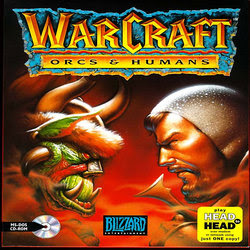
Warcraft: Orcs & Humans is a real-time strategy game, developed and published by Blizzard Entertainment in 1994.[1] The real-time strategy genre had been pioneered by Dune II, but Warcraft (along with Westwood Studios' Command & Conquer) is widely credited for the genre's rise in popularity.
The game is set in the Kingdom of Azeroth, part of the fictional Warcraft universe. The events that take place in this game are known in Warcraft lore as the First War or the Great War.
Story
The human mage Medivh, scion of a mortal human and one of the last guardians, comes under the influence of the long dead dark Titan, Sargeras. Mad with lust and power, he offers the world of Azeroth to the bloodthirsty Orcs in exchange for the Titan's powers and unanswering loyalty of the Orcish Horde.
The Orcs begin a swift invasion of Azeroth but are, at first, beaten back and Medivh himself is slain, putting an end to his quest for power and domination. However, fortunes turn when the Orcs assassinate King Llane, sack Stormwind Keep (the capital of Azeroth), and drive the humans from Azeroth to Lordaeron.
Units and structures
As with most real-time strategy computer games at the time, Warcraft featured two opposing factions, the noble Humans and the savage Orcs. The goal of most scenarios is to destroy the enemy.
The working units are Human Peasants and Orc Peons; they harvest lumber, mine gold and build and repair buildings, which enable creating more advanced units or researching better weapons, thus improving parameters of units.
Various units serve different purposes in combat. Footmen (or faster and stronger Knights) are the basic fighting units; they attack from proximity and are used to protect weaker units from being reached by enemies. Archers or Orc Spearmen can attack any unit in their range and are therefore effective in finishing damaged units. Catapults throw missiles that deal heavy damage to nine squares at the same time; as they cannot aim at an empty square, it is difficult for them to hit a moving unit.
Clerics and Conjurers are vulnerable spellcasters that can heal damaged units, explore any segment of map, make a unit invisible, cast a rain of fire or summon Scorpions (weak units useful for exploring) or a mighty Water elemental. Their Orc counterparts, Necrolytes and Warlocks, have partly different spells, they can summons Spiders (Scorpions counterpart), turn dead units into Skeletons, make a unit invulnerable and summon a Fire elemental or a Daemon, the most powerful unit in the game.
Counterparts
Each faction’s units and buildings have a counterpart within the other faction. With the exception of some spells, each unit is basically the same as its counterpart, with only slight variations. For example, Orc Spearmen do slightly more damage than Human Archers while having a slightly reduced range.
The only units which are exclusive and have no counterpart in the game are the Daemons (Summoned by Orcish Warlocks) and the Water Elementals (Summoned by Human Conjurers). Both are. it is the most powerful units for each faction, the Daemons though are slow melee attackers with more HP and damage output, while the Water Elementals are ranged units. While subtle, these units provided something that would be kept in the series and give each race its flavour: The orcs could wreak havoc using invulnerable Daemons enchanted with Unholy Armor, while humans could simply pass by heavy defenses using Invisible Water Elementals.
Download
Password: joex
enjoy